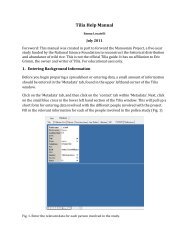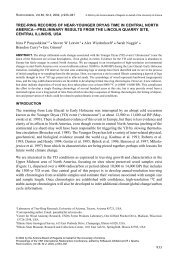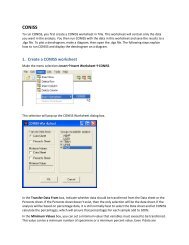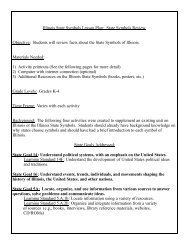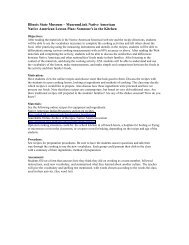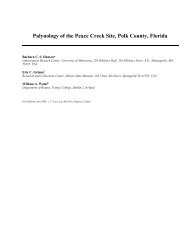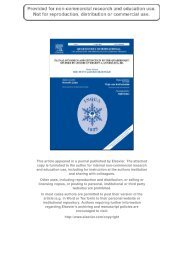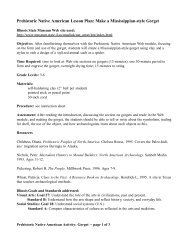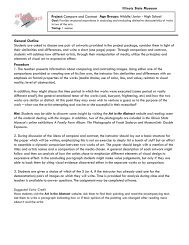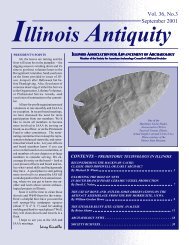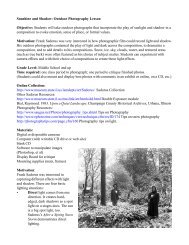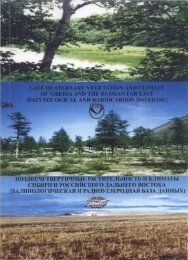Predicting the Past - Illinois State Museum
Predicting the Past - Illinois State Museum
Predicting the Past - Illinois State Museum
You also want an ePaper? Increase the reach of your titles
YUMPU automatically turns print PDFs into web optimized ePapers that Google loves.
Lesson Plan: <strong>Predicting</strong> <strong>the</strong> <strong>Past</strong><strong>Illinois</strong> Goals and Standards addressed:Grade Levels: 6-12ScienceGoal 11: Understand <strong>the</strong> processes of scientific inquiry and technological design to investigate questions,conduct experiments, and solve problems.Standard A: Know and apply <strong>the</strong> concepts, principles, and processes of scientific inquiry.Late Elementary: 11.A.2d: use data to produce reasonable explanations.Early and Late High School: 11.A.4a and 5a: Formulate hypo<strong>the</strong>ses, referencing priorresearch and knowledge.Social ScienceGoal 16: Understand events, trends, individuals, and movements shaping <strong>the</strong> history of <strong>Illinois</strong>, <strong>the</strong>United <strong>State</strong>s, and o<strong>the</strong>r nations.Standard A: Apply <strong>the</strong> skills of historical analysis and interpretation.Late Elementary: 16.A.2b: Ask questions and seek answers from historical documents,images, and o<strong>the</strong>r literary and non-literary sources.Middle/Junior High: 16.A.3b: Make inferences about historical events and eras usinghistorical maps and o<strong>the</strong>r historical sources.Early High School: 16.A.4a: Analyze and report historical events to determine cause andeffect relationships.Late High School: 16.A.5b: Explain <strong>the</strong> tentative nature of historicalinterpretations......serve as expressions of culture.Language Arts: Listening (if journal entry is read aloud to students)Goal 4: Listen and speak effectively in a variety of situations.Standard A: Listen effectively in formal and informal situations.Language Arts: Reading (if journal entry is printed out and read by students)Goal 2: Read and understand literature representative of various societies, eras, and ideas.Standard B: Read and interpret a variety of literary works.<strong>Illinois</strong> <strong>State</strong> <strong>Museum</strong> Web site used:<strong>Museum</strong>Link <strong>Illinois</strong> Native American, Historic, Neighbors, French, link from Jacques Marquette.<strong>Museum</strong>LInk <strong>Illinois</strong>, Behind <strong>the</strong> Scenes, Research and collections, Anthropology, Field and Lab Workhttp://www.museum.state.il.us/muslink/behind/htmls/cr_an_fl.htmlBehind <strong>the</strong> Scenes, Exhibits, Falcon Dancerhttp://www.museum.state.il.us/muslink/behind/htmls/exh_fal.htmlObjective: After reading or listening to, and discussing Jacques Marquette's journal entries in <strong>the</strong> Website, and discussing what archaeologists do and what <strong>the</strong>y find and do not find, <strong>the</strong>y will be able to sortthrough <strong>the</strong> list <strong>the</strong>y make on <strong>the</strong> chalkboard of artifacts (materials of life) that Marquette saw, held, orused. From this list, <strong>the</strong>y will write a shorter list of those artifacts which would have survived longenough for a 20th century archaeologist to have found <strong>the</strong>m. They should also give <strong>the</strong> reasons for <strong>the</strong>irchoices.Time Required:60 minutes on <strong>the</strong> web sites30 minutes to compile listMaterials:computer with Internet connection to read journal entriesoptional printer and xerox for individual copies of journal entrylist of archaeological finds from <strong>Illinois</strong> village site (printed or overhead)paper and penchalkboard
Procedure:Part One:Students have access to read <strong>the</strong> various parts of <strong>the</strong> ISM <strong>Museum</strong>Link <strong>Illinois</strong> Web sitepertaining to <strong>the</strong> lesson. Teacher reviews with a 5-10 minute whole class discussion ofarchaeology. Teacher reads aloud journal entry while students listen for artifacts and remains tolist on <strong>the</strong> chalkboard.Then <strong>the</strong>y cross off perishable materials and telling why <strong>the</strong>y didn't last,leaving <strong>the</strong> artifacts and remains an archaeologist may have found.ORStudents study list for artifacts that may survive hundreds of years in <strong>the</strong> ground, and make a listof each one <strong>the</strong>y choose, also telling why <strong>the</strong>y chose it.Part Two:Project a transparency copy of <strong>the</strong> list of artifacts and remains that archaeologists found at <strong>the</strong><strong>Illinois</strong> Village Marquette visited. Orally go through each item on this list and have students tellwhy it was found 200 years later.Discussion Questions to Think About:1.Some items (like trade goods) on <strong>the</strong> site were not specified in <strong>the</strong> journal entry. Why are <strong>the</strong>yat <strong>the</strong> site?2.Some items that marquette mentioned were not found at <strong>the</strong> dig. Why not?3.Were you surprised about any of <strong>the</strong> remains or artifacts that survived?4.How is it helpful to have written accounts from <strong>the</strong> actual time period of <strong>the</strong> site?5.What more do you know about <strong>the</strong> Peoria Indians from knowing what materials <strong>the</strong>y used?Assessment: At <strong>the</strong> end of <strong>the</strong> Native American unit using <strong>the</strong> <strong>Museum</strong>link Native American Web Siteand activities, include some written questions about objects found and not found ( with possible reasons)at archaeological sites of Indian villages in <strong>Illinois</strong>. (See sample test) Assessment for <strong>Predicting</strong> <strong>the</strong> <strong>Past</strong>NameAnswer <strong>the</strong> following questions in your own words, using <strong>the</strong> information you learned in <strong>the</strong> web activityon archaeology.1. Name three man-made objects that Jacques Marquette saw Peoria Indians use in <strong>the</strong> village hevisited.1.2.3.2. Which of <strong>the</strong>se three objects, if any, survived in whole or part long enough to be dug up byarchaeologists?Why did <strong>the</strong>y survive?1.2.3.3. Name three foods that he saw <strong>the</strong> Indians eating.
1.2.3.4. What parts, if any, of <strong>the</strong>se foods, were found 200 years later in <strong>the</strong> archaeological dig at <strong>the</strong> site?Why weren't <strong>the</strong> whole foods found?1.2.3.5. How would reading Marquette's journal help archaeologists do <strong>the</strong>ir job?Extension Activity: Once students are aware of <strong>the</strong> dynamics of artifacts and remains found versusartifacts and remains (materials) used by people in <strong>the</strong>ir time, <strong>the</strong>y can use this knowledge as <strong>the</strong>y read<strong>the</strong> Historic Native American Web module.
Resources:EXCERPTS FROM FATHER JACQUES MARQUETTE'S JOURNALIn 1673, <strong>the</strong> Governor of New France authorized a young fur trader, Louis Jolliet, to explore <strong>the</strong>Mississippi River, which he hoped would lead to a water route for trade to <strong>the</strong> Gulf of Mexico. Jolliet wasaccompanied on this journey by <strong>the</strong> Jesuit missionary Jacques Marquette and five o<strong>the</strong>r people. Theparty of explorers entered <strong>the</strong> upper Mississippi River from <strong>the</strong> Wisconsin River. In what is now Missouri,<strong>the</strong>y found several villages of <strong>Illinois</strong> Indians. They stayed for several days with <strong>the</strong> Peoria tribe of <strong>Illinois</strong>Indians at a village that had over three hundred houses.Following are excerpts from Fa<strong>the</strong>r Jacques Marquette's journal. Remember that <strong>the</strong> wording used in thisjournal is from <strong>the</strong> late 1600s.SECTION 4TH. OF THE GREAT RIVER CALLED MISSISSIPPI; ITS MOST NOTABLE FEATURES; OFVARIOUS ANIMALS AND ESPECIALLY THE PISIKIOUS OR WILD CATTLE, THEIR SHAPE ANDNATURE; OF THE FIRST VILLAGES OFTHE ILINOIS, WHERE THE FRENCH ARRIVED.Here we are, <strong>the</strong>n, on this so renowned River, all of whose peculiar features I have endeavored to notecarefully. The Missisipi River takes its rise in various lakes in <strong>the</strong> country of <strong>the</strong> Nor<strong>the</strong>rn nations.Finally, on <strong>the</strong> 25th of June, we perceived on <strong>the</strong> water's edge some tracks of men, and a narrow andsomewhat beaten path leading to a fine prairie. We stopped to Examine it; and, thinking that it was aroad which Led to some village of savages, We resolved to go and reconnoiter [inspect] it. We <strong>the</strong>reforeleft our two Canoes under <strong>the</strong> guard of our people, strictly charging Them not to be surprised, afterwhich Monsieur Jollyet [Jolliet] and I undertook this investigation -- a ra<strong>the</strong>r hazardous one for two menwho exposed <strong>the</strong>mselves, alone, to <strong>the</strong> mercy of a barbarous and Unknown people. We silently followedThe narrow path, and, after walking About 2 leagues, We discovered a village on <strong>the</strong> bank of a river, andtwo o<strong>the</strong>rs on a Hill distant about half a league from <strong>the</strong> first.SECTION 6TH. OF THE CHARACTER OF THE ILINOIS; OF THEIR HABITS AND CUSTOMS; AND OFTHE ESTEEM THAT THEY HAVE FOR THE CALUMET, OR TOBACCO-PIPE, AND OF THE DANCETHEY PERFORM IN ITS HONOR.They are divided into many villages, some of which are quite distant from that of which we speak, whichis called peouarea [Peoria]. [Note: The Peoria tribe was a branch of <strong>the</strong> <strong>Illinois</strong> whose later home wason <strong>the</strong> <strong>Illinois</strong> River near <strong>the</strong> city of <strong>the</strong>ir name.] This causes some difference in <strong>the</strong>ir language, which,on <strong>the</strong> whole, resembles allegonquin [Algonquian], so that we easily understood each o<strong>the</strong>r. They are ofa gentle and tractable disposition; we Experienced this in <strong>the</strong> reception which <strong>the</strong>y gave us.Their Bodies are shapely; <strong>the</strong>y are active and very skillful with bows and arrows. They also use guns,which <strong>the</strong>y buy from our savage allies who Trade with our french. They use <strong>the</strong>m especially to inspire,through <strong>the</strong>ir noise and smoke, terror in <strong>the</strong>ir Enemies; <strong>the</strong> latter do not use guns, and have never seenany, since <strong>the</strong>y live too Far toward <strong>the</strong> West. They are warlike, and make <strong>the</strong>mselves dreaded by <strong>the</strong>Distant tribes to <strong>the</strong> south and west, whi<strong>the</strong>r <strong>the</strong>y go to procure Slaves; <strong>the</strong>se <strong>the</strong>y barter, selling <strong>the</strong>mat a high price to o<strong>the</strong>r Nations, in exchange for o<strong>the</strong>r Wares. Those very Distant Savages against whom<strong>the</strong>y war have no Knowledge of Europeans; nei<strong>the</strong>r do <strong>the</strong>y know anything of iron, or of Copper, and<strong>the</strong>y have only stone Knives. When <strong>the</strong> Ilinois depart to go to war, <strong>the</strong> whole village must be notified bya loud Shout, which is uttered at <strong>the</strong> doors of <strong>the</strong>ir Cabins, <strong>the</strong> night and The Morning before <strong>the</strong>irdeparture. The captains are distinguished from <strong>the</strong> warriors by wearing red Scarfs. These are made, withconsiderable Skill, from <strong>the</strong> Hair of bears and wild cattle [bison]. They paint <strong>the</strong>ir faces with red ocher[a red pigment made of iron oxide], great quantities of which are found at a distance of some days'journey from <strong>the</strong> village. They live by hunting, game being plentiful in that country, and on indian corn,of which <strong>the</strong>y always have a good crop; consequently, <strong>the</strong>y have never suffered from famine. They alsosow beans and melons, which are Excellent, especially those that have red seeds. Their Squashes arenot of <strong>the</strong> best; <strong>the</strong>y dry <strong>the</strong>m in <strong>the</strong> sun, to eat <strong>the</strong>m during The winter and <strong>the</strong> spring. Their Cabinsare very large, and are Roofed and floored with mats made of Rushes. They make all Their utensils of
wood, and <strong>the</strong>ir Ladles out of <strong>the</strong> heads of cattle, whose Skulls <strong>the</strong>y know so well how to prepare that<strong>the</strong>y use <strong>the</strong>se ladles with ease for eating <strong>the</strong>ir sagamité[corn meal boiled in water and seasoned withfat]. There remains no more, except to speak of <strong>the</strong> Calumet [a decorated tobacco pipe used in rituals].There is nothing more mysterious or more respected among <strong>the</strong>m. Less honor is paid to <strong>the</strong> Crowns andscepters of Kings than <strong>the</strong> Savages bestow upon this. It seems to be <strong>the</strong> God of peace and of war, <strong>the</strong>Arbiter of life and of death. It has but to be carried upon one's person, and displayed, to enable one towalk safely through <strong>the</strong> midst of Enemies -- who, in <strong>the</strong> hottest of <strong>the</strong> Fight, lay down Their arms whenit is shown. For That reason, <strong>the</strong> Ilinois gave me one, to serve as a safeguard among all <strong>the</strong> Nationsthrough whom I had to pass during my voyage. There is a Calumet for peace, and one for war, which aredistinguished solely by <strong>the</strong> Colors of <strong>the</strong> fea<strong>the</strong>rs with which <strong>the</strong>y are adorned; Red is a sign of war. Theyalso use it to put an end to Their disputes, to streng<strong>the</strong>n Their alliances, and to speak to Strangers. It isfashioned from a red stone, polished like marble, and bored in such a manner that one end serves asreceptacle for <strong>the</strong> tobacco, while <strong>the</strong> o<strong>the</strong>r fits into <strong>the</strong> stem; this is a stick two feet long, as thick as anordinary cane, and bored through <strong>the</strong> middle. It is ornamented with <strong>the</strong> heads and necks of variousbirds, whose plumage is very beautiful. To <strong>the</strong>se <strong>the</strong>y also add large fea<strong>the</strong>rs, -- red, green, and o<strong>the</strong>rcolors, -- wherewith <strong>the</strong> whole is adorned. They have a great regard for it, because <strong>the</strong>y look upon it as<strong>the</strong> calumet of <strong>the</strong> Sun; and, in fact, <strong>the</strong>y offer it to <strong>the</strong> latter to smoke when <strong>the</strong>y wish to obtain acalm, or rain, or fine wea<strong>the</strong>r.LIST OF ARTIFACTS AND FOODS DESCRIBED INFATHER JACQUES MARQUETTE'S JOURNALFa<strong>the</strong>r Jacques Marquette describes several artifacts and food items in <strong>the</strong> excerpt from his journal.Those items are listed below. An asterisk marks <strong>the</strong> items that were partially or completely preserved atan <strong>Illinois</strong> village archaeological site.* wild cattle (bison scapula hoes were found at <strong>the</strong> site suggesting that bison were hunted)* calumet (a decorated tobacco pipe used in rituals)- bows* arrows (chipped-stone arrowpoints were found at <strong>the</strong> site, <strong>the</strong> wooden shaft probably decayed)* guns (various parts of guns were found at <strong>the</strong> site)* iron* copper* stone knives* cabins (postholes were found suggesting where <strong>the</strong> cabins were built)- red scarves (made from <strong>the</strong> hair of bear and wild cattle)- red ocher (a type of red earthy mineral used to make paint)* animal game (bison bones were found at <strong>the</strong> site, but not much o<strong>the</strong>r evidence of game)* Indian corn (charred corn cobs and kernels were found)* beans (charred bean seeds were found)* melons (charred watermlon seeds were found)- red seeds* squash (charred squash rinds were found)* mats made of rushes (rushes are grasslike marsh plants, such as bulrushes and cattails;a mat-weaving tool was found suggesting that mats were made at this site)- utensils of wood- ladles out of <strong>the</strong> skulls of cattle- sagamité (a type of corn dish)* red stone that is polished and drilled for a pipe- cane stem to use with <strong>the</strong> pipe- birds with beautiful plumage- large colorful fea<strong>the</strong>rs - red, green, etc.ARCHAEOLOGICAL FINDS AT THE ILLINOIS VILLAGE
OF THE MARQUETTE / JOLLIET EXPEDITION OF 1673The Haas and Hagerman sites in nor<strong>the</strong>ast Missouri are historic American Indian sites from <strong>the</strong> time ofcontact with <strong>the</strong> Europeans. These sites are located on <strong>the</strong> eastern edge of a high sand terrace in <strong>the</strong>Des Moines River floodplain. They fit <strong>the</strong> description (both geographically and chronologically) of <strong>the</strong><strong>Illinois</strong> villages visited by <strong>the</strong> Marquette and Jolliet expedition of 1673. All of <strong>the</strong> materials recovered and<strong>the</strong> radiocarbon dates indicate that <strong>the</strong> site was occupied between 1625 - 1675.Artifacts found at <strong>the</strong> sites include:- fired clay pottery- stone arrow points- stone knives- sandstone blocks used as awl sharpeners- two catlinite (polished red stone) pipes & one large limestone pipe- bone tools:- one mat weaving tool- bison scapula hoe blades- antler tools- trade goods:- copper and brass beads and ornamental tinkling cones- straight wire segments, coils, and bracelets- one upper half of a hawk bell- one spheroid copper bead- blue and black, glass, necklace beads of small and medium sizes- glass chevron beads (with a star pattern at each end)- iron knife blades, wire, awls, a ring fragment, and <strong>the</strong> bit of two axes- one high relief, cast silver, Jesuit ring (probably pre-1700)- gun parts - gun plate fragments, one upper cock jaw, one French and three native made gunflintsPlant remains found at <strong>the</strong> site include:- cornbeanssquashbottlegourdswatermelontobaccoFeatures found at <strong>the</strong> sites include:- postholes of a large longhouse with hearths and deep storage pits(<strong>the</strong> floor area is approximately 22 x 9 meters)- four o<strong>the</strong>r possible longhouses and <strong>the</strong> edges of o<strong>the</strong>rsonecircular structure
Sources for Marquette's Journal and Illinios VillageGrantham, Larry. 1996. Excavations At Illiniwek Village <strong>State</strong> Historic Site: The Illini Village of <strong>the</strong>Jolliett/Marquette Expedition of 1673. Paper presented at <strong>the</strong> annual meeting of <strong>the</strong> Society forHistorical Archaeology. Cincinnati, OH.Grantham, Larry. 1996. "The Illini village of <strong>the</strong> Marquette and Jolliet voyage of 1673." The MissouriArchaeologist 54: 1-20.Hollinger, Eric. 1999. Personal communication to Robert E. Warren, <strong>Illinois</strong> <strong>State</strong> <strong>Museum</strong>, Springfield, IL.Marquette, Jacques. 1959b. Of <strong>the</strong> first voyage made by Fa<strong>the</strong>r Marquette toward new Mexico, and how<strong>the</strong> idea <strong>the</strong>reof was conceived [Original manuscript 1674]. In The Jesuit relations and allieddocuments, Vol.59, edited by Reuben Gold Thwaites, pp. 109-131. Pageant, New York, NY.Sources for activityAvi-Yonah, Michael, 1904-1974. Dig this! : how archaeologists uncover our past. Minneapolis :Runestone Press, c1993. [juvenile]Cole, Joanna. The magic school bus shows and tells : a book about archaeology. New York :Scholastic, c1997. [juvenile]Duke, Kate. Archaeologists dig for clues. New York : HarperCollins, c1997. [juvenile]Murdoch, David Hamilton, 1937-. North American Indian. 1st American ed. New York :Knopf in association with <strong>the</strong> American <strong>Museum</strong> of Natural History: Distributed byRandom House, 1995. [juvenile]Index of Native American Resources on <strong>the</strong> Web. Would need to pick and choose pertinent good ones.http://www.hanksville.org/NAresources/Short Marquette and Jolliet page on explorers site by junior highhttp://tqjunior.advanced.org/4034/marquettejolliet.htmlMarquette and Jolliet on site of Virtual museum of new-Francehttp://www.vmnf.civilization.ca/Explor/marqu_e2.htmWeb site of <strong>the</strong> Peoria Tribe Indians of Oklahomahttp://www.peoriatribe.com/



